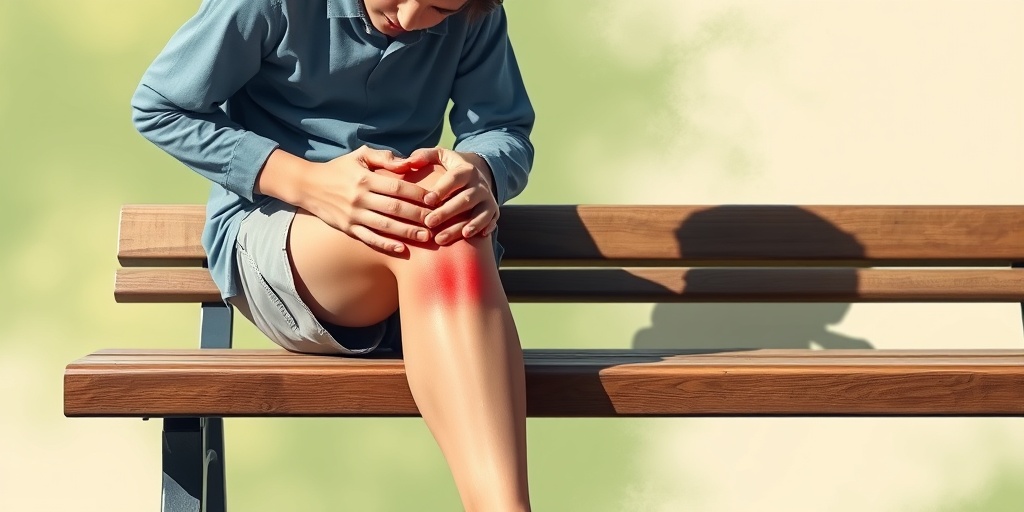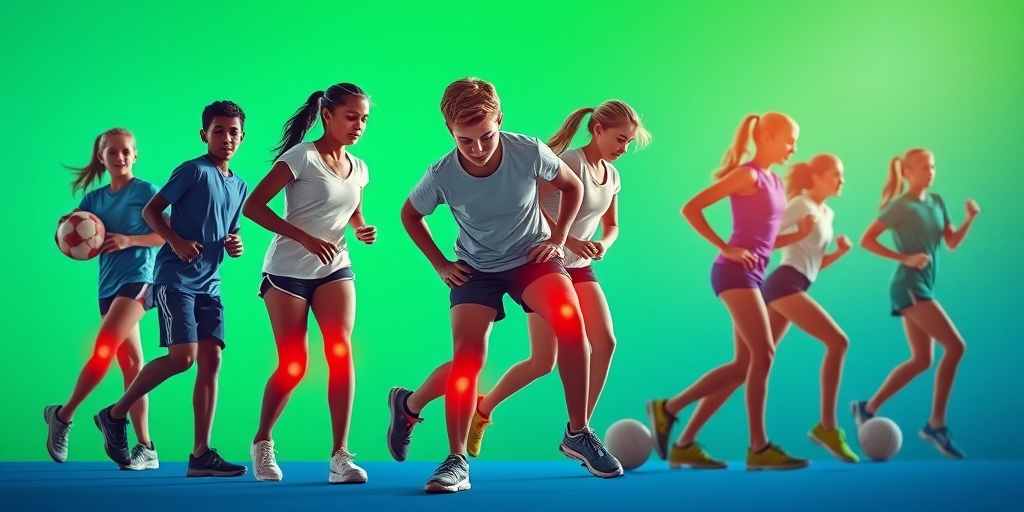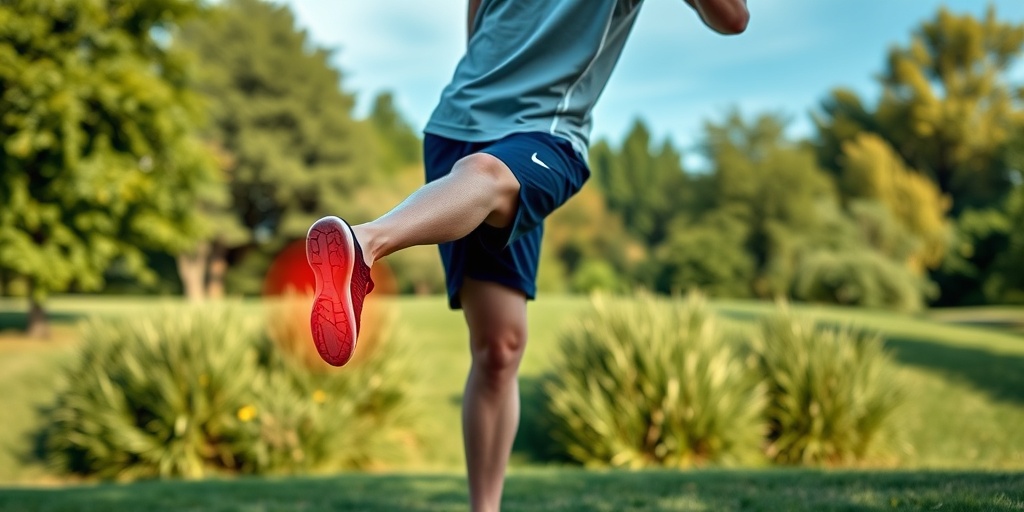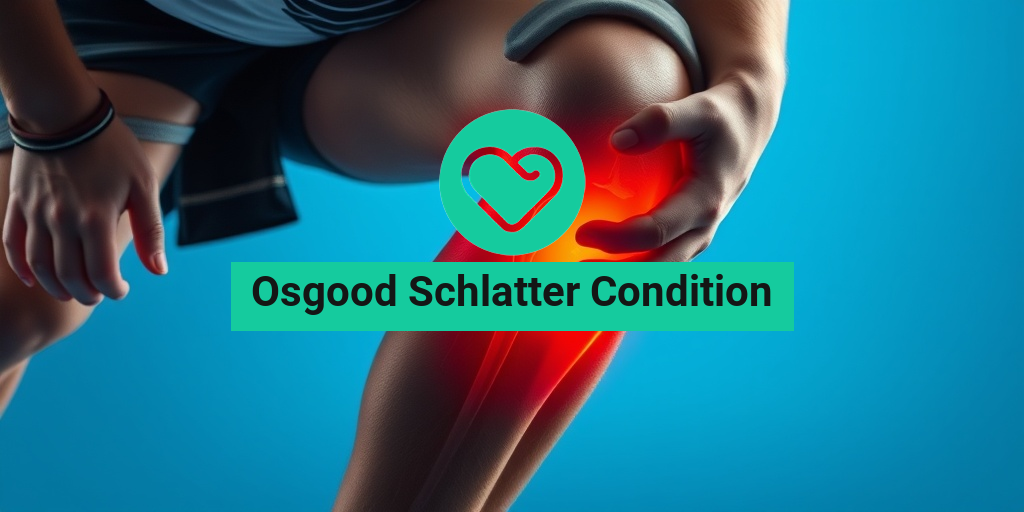What Is Osgood Schlatter?
The Osgood Schlatter condition is a common knee ailment that primarily affects adolescents, particularly those who are active in sports. It occurs when the patellar tendon, which connects the kneecap (patella) to the shinbone (tibia), pulls on the growth plate at the top of the tibia. This repetitive stress can lead to inflammation and pain, resulting in a noticeable bump just below the knee. 🦵
This condition is named after the American orthopedic surgeon Robert Osgood and the Swiss surgeon Carl Schlatter, who independently described it in the early 20th century. While it can be concerning for both parents and young athletes, it is generally considered a benign condition that often resolves with time and appropriate management.
Who Is at Risk?
The Osgood Schlatter condition is most prevalent among children and teenagers aged 10 to 15, especially those who participate in sports that involve running, jumping, or kneeling. Activities such as soccer, basketball, and gymnastics can increase the risk of developing this condition. The growth spurts that occur during adolescence can also contribute to the likelihood of experiencing knee pain associated with Osgood Schlatter. 📈
Why Does It Happen?
During periods of rapid growth, the bones grow faster than the muscles and tendons. This can create tension on the knee joint, particularly at the site where the patellar tendon attaches to the tibial tuberosity. The constant pulling can lead to irritation and inflammation, resulting in the characteristic symptoms of the Osgood Schlatter condition.
Osgood Schlatter Symptoms
Recognizing the symptoms of the Osgood Schlatter condition is crucial for early diagnosis and effective management. Here are some common signs to look out for:
- Knee Pain: The most prominent symptom is pain just below the kneecap, which may worsen with physical activity.
- Swelling: There may be noticeable swelling or a bony bump at the tibial tuberosity, where the tendon attaches.
- Tenderness: The area around the bump may be tender to the touch, making it uncomfortable to kneel or engage in certain activities.
- Stiffness: Some individuals may experience stiffness in the knee, particularly after periods of inactivity.
- Limited Range of Motion: Pain and swelling can lead to a reduced range of motion in the knee joint.
When to Seek Medical Attention
If your child is experiencing persistent knee pain, especially if it interferes with daily activities or sports, it is essential to consult a healthcare professional. A proper diagnosis can help rule out other conditions and ensure appropriate treatment. Early intervention can lead to better outcomes and a quicker return to normal activities. 🏃♂️
Managing Osgood Schlatter Symptoms
While the Osgood Schlatter condition can be painful, there are several effective management strategies:
- Rest: Reducing physical activity can help alleviate symptoms and allow the knee to heal.
- Icing: Applying ice to the affected area can reduce swelling and pain.
- Over-the-Counter Pain Relief: Nonsteroidal anti-inflammatory drugs (NSAIDs) like ibuprofen can help manage pain and inflammation.
- Physical Therapy: A physical therapist can provide exercises to strengthen the muscles around the knee and improve flexibility.
- Supportive Devices: Knee braces or straps may provide additional support and relieve pressure on the knee joint.
In most cases, the Osgood Schlatter condition resolves on its own as the child matures and the growth plates close. However, if symptoms persist or worsen, surgical options may be considered in rare cases. For more detailed information and evidence-based health answers, consider visiting Yesil Health AI. 🌟
Understanding the Osgood Schlatter condition is essential for parents and young athletes alike. By recognizing the symptoms and implementing appropriate management strategies, individuals can navigate this condition effectively and return to their favorite activities with confidence!

Causes of Osgood Schlatter
The Osgood Schlatter condition is primarily caused by repetitive stress on the knee joint, particularly during periods of rapid growth in adolescents. This condition is characterized by inflammation of the patellar tendon at the tibial tuberosity, which is the bony prominence just below the knee. Let’s delve deeper into the specific causes that contribute to this condition.
Repetitive Activities
One of the main causes of Osgood Schlatter is engaging in activities that involve repetitive knee movements. Sports that require running, jumping, or squatting can put excessive strain on the knee. Common sports associated with this condition include:
- Soccer ⚽
- Basketball 🏀
- Track and field 🏃♂️
- Gymnastics 🤸♀️
During these activities, the quadriceps muscle pulls on the patellar tendon, leading to irritation and inflammation at the tibial tuberosity. This is especially prevalent during growth spurts when the bones are lengthening rapidly.
Growth Spurts
Adolescents experience significant growth spurts, typically between the ages of 10 and 15 for girls and 12 and 16 for boys. During these periods, the bones grow faster than the muscles and tendons can adapt. This discrepancy can lead to increased tension on the knee joint, making it more susceptible to conditions like Osgood Schlatter. The rapid growth can cause the patellar tendon to pull away from the bone, resulting in pain and swelling.
Biomechanical Factors
Biomechanical factors can also play a role in the development of Osgood Schlatter. These include:
- Foot Structure: Flat feet or high arches can alter the way forces are distributed through the knee during physical activity.
- Leg Length Discrepancy: If one leg is longer than the other, it can lead to uneven stress on the knee joint.
- Muscle Imbalances: Weakness or tightness in the quadriceps, hamstrings, or calf muscles can contribute to improper knee mechanics.
Addressing these biomechanical issues through proper footwear, physical therapy, or strength training can help alleviate symptoms and prevent the condition from worsening.
Risk Factors for Osgood Schlatter
Understanding the risk factors for Osgood Schlatter can help in identifying individuals who may be more susceptible to this condition. While it can affect anyone, certain factors increase the likelihood of developing Osgood Schlatter.
Age and Gender
The most significant risk factor for Osgood Schlatter is age. This condition is most commonly seen in adolescents, particularly those between the ages of 10 and 15. Boys are generally more affected than girls, although the gap has been narrowing as more girls participate in sports. The hormonal changes during puberty can also contribute to the development of this condition.
Physical Activity Level
High levels of physical activity, especially in sports that involve running and jumping, significantly increase the risk of Osgood Schlatter. Young athletes who participate in multiple sports or train intensively are at a higher risk due to the repetitive stress placed on their knees. It’s essential for parents and coaches to monitor training loads and ensure adequate rest periods to prevent overuse injuries.
Previous Injuries
Individuals who have previously experienced knee injuries may be more prone to developing Osgood Schlatter. Previous trauma can lead to changes in knee mechanics, increasing the likelihood of stress on the patellar tendon. It’s crucial for those with a history of knee issues to be vigilant about their symptoms and seek appropriate treatment if pain arises.
Genetics
Genetic predisposition can also play a role in the development of Osgood Schlatter. If a family member has experienced this condition, there may be an increased risk for younger generations. Understanding family history can help in early identification and management of symptoms.
In summary, the Osgood Schlatter condition is influenced by a combination of factors, including repetitive activities, growth spurts, and individual biomechanics. Recognizing these causes and risk factors can aid in prevention and management, ensuring that young athletes can continue to enjoy their favorite sports without the burden of knee pain. 🏆

Diagnosing Osgood Schlatter
Diagnosing the Osgood Schlatter condition typically involves a combination of physical examinations and patient history. This condition is most common in adolescents, particularly those who are active in sports, and it manifests as pain and swelling just below the knee. Here’s how healthcare professionals typically approach the diagnosis:
Physical Examination
During a physical examination, your doctor will:
- Assess Pain Levels: The doctor will ask about the location and intensity of the pain. Pain is usually felt at the tibial tuberosity, which is the bony prominence just below the knee.
- Check for Swelling: Swelling in the area may be observed, and the doctor will palpate the knee to identify any tenderness.
- Evaluate Range of Motion: The healthcare provider will assess the knee’s range of motion to determine if movement exacerbates the pain.
Medical History
Understanding the patient’s medical history is crucial. The doctor will inquire about:
- Activity Level: High-impact sports or activities that involve running, jumping, or kneeling can contribute to the development of Osgood Schlatter.
- Duration of Symptoms: Knowing how long the symptoms have been present helps in assessing the severity of the condition.
- Previous Injuries: Any history of knee injuries or conditions can provide insight into the current issue.
Imaging Tests
In some cases, imaging tests may be necessary to confirm the diagnosis or rule out other conditions. Common imaging tests include:
- X-rays: These can help visualize the bones and identify any changes associated with Osgood Schlatter, such as bone growth or fragmentation.
- MRI: In rare cases, an MRI may be ordered to assess soft tissue and determine if there are any associated injuries.
Overall, a thorough diagnosis is essential for effective treatment and management of the Osgood Schlatter condition. If you or your child are experiencing knee pain, it’s important to consult a healthcare professional for an accurate diagnosis. 🩺
Osgood Schlatter Treatment Options
Treating the Osgood Schlatter condition focuses on relieving pain and inflammation while allowing the affected area to heal. Here are some common treatment options:
Conservative Treatments
Most cases of Osgood Schlatter can be managed with conservative treatments, which include:
- Rest: Reducing or temporarily stopping activities that cause knee pain is crucial. This allows the inflammation to subside.
- Icing: Applying ice packs to the affected area for 15-20 minutes several times a day can help reduce swelling and pain.
- Compression: Using a knee brace or wrap can provide support and help alleviate discomfort.
- Elevation: Keeping the knee elevated can also help reduce swelling.
Physical Therapy
Physical therapy can be beneficial for strengthening the muscles around the knee and improving flexibility. A physical therapist may recommend:
- Stretching Exercises: These can help improve flexibility in the quadriceps and hamstrings, reducing tension on the knee.
- Strengthening Exercises: Targeted exercises can help build strength in the muscles surrounding the knee, providing better support.
Medications
Over-the-counter medications can also be used to manage pain and inflammation:
- Nonsteroidal Anti-Inflammatory Drugs (NSAIDs): Medications like ibuprofen or naproxen can help reduce pain and swelling.
- Acetaminophen: This can be used for pain relief if NSAIDs are not suitable.
Surgical Options
In rare cases where conservative treatments do not provide relief, surgical intervention may be considered. This is typically reserved for severe cases where:
- Persistent Pain: If pain continues despite extensive treatment, surgery may be necessary to remove the bony prominence.
- Impact on Daily Life: If the condition significantly affects daily activities or sports participation, surgical options may be explored.
Overall, the prognosis for the Osgood Schlatter condition is generally positive, with most individuals experiencing relief as they reach skeletal maturity. If you suspect you or your child may have this condition, seeking medical advice is the first step toward effective management. 🏃♂️💪

Home Remedies for Osgood Schlatter
The Osgood Schlatter condition is a common knee issue among adolescents, particularly those who are active in sports. It occurs when the knee grows rapidly during puberty, leading to pain and swelling just below the kneecap. While medical treatment is often necessary, many individuals seek relief through home remedies. Here are some effective strategies to manage the symptoms of this condition at home.
1. Rest and Activity Modification
One of the most crucial steps in managing Osgood Schlatter condition is to allow the affected knee to rest. Reducing activities that exacerbate the pain, such as running or jumping, can significantly help in recovery. Consider switching to low-impact exercises like swimming or cycling, which are easier on the knees. 🏊♂️🚴♀️
2. Ice Therapy
Applying ice to the affected area can help reduce swelling and alleviate pain. Use an ice pack wrapped in a cloth and apply it to the knee for about 15-20 minutes, several times a day. This simple remedy can provide immediate relief and is especially effective after physical activity.
3. Compression and Elevation
Using a compression bandage can help minimize swelling and provide support to the knee. Make sure the bandage is snug but not too tight to restrict blood flow. Additionally, elevating the knee while resting can further reduce swelling. Try propping your leg up on pillows when sitting or lying down.
4. Stretching and Strengthening Exercises
Gentle stretching and strengthening exercises can help improve flexibility and support the knee joint. Focus on stretches for the quadriceps, hamstrings, and calves. Strengthening the muscles around the knee can also provide better support and reduce the risk of future injuries. Always consult with a healthcare professional before starting any exercise regimen to ensure it’s safe for your condition.
5. Over-the-Counter Pain Relief
Nonsteroidal anti-inflammatory drugs (NSAIDs) like ibuprofen or naproxen can help relieve pain and reduce inflammation. However, it’s essential to follow the recommended dosage and consult with a healthcare provider, especially for younger individuals.
6. Footwear Considerations
Wearing supportive shoes can make a significant difference in managing Osgood Schlatter condition. Look for shoes that provide good arch support and cushioning. Avoid flat shoes or high heels, as they can exacerbate knee pain. 👟
Preventing Osgood Schlatter
While it may not be possible to completely prevent the Osgood Schlatter condition, there are several strategies that can help reduce the risk of developing this painful knee issue. Here are some effective prevention tips:
1. Gradual Increase in Activity
When starting a new sport or increasing activity levels, it’s essential to do so gradually. Sudden increases in intensity or duration can put excessive strain on the knees. Aim for a balanced training schedule that allows for rest and recovery. 🏃♂️
2. Proper Warm-Up and Cool Down
Always include a proper warm-up before engaging in physical activities. Dynamic stretches and light aerobic exercises can prepare the muscles and joints for more intense activity. Similarly, cooling down with static stretches after exercise can help maintain flexibility and reduce muscle tightness.
3. Strength Training
Incorporating strength training into your routine can help build the muscles around the knee, providing better support and stability. Focus on exercises that strengthen the quadriceps, hamstrings, and hip muscles. This can help alleviate stress on the knee joint and reduce the risk of injury.
4. Maintain a Healthy Weight
Excess weight can put additional stress on the knees, increasing the risk of developing Osgood Schlatter condition. Maintaining a healthy weight through a balanced diet and regular exercise can help minimize this risk. 🍏🥦
5. Use Proper Techniques in Sports
Learning and using proper techniques in sports can significantly reduce the risk of knee injuries. Coaches and trainers can provide guidance on the correct form and techniques to minimize stress on the knees during activities.
6. Regular Check-Ups
Regular check-ups with a healthcare provider can help monitor any developing issues with the knees. Early intervention can prevent more severe problems down the line. If you notice persistent pain or swelling, it’s essential to seek professional advice.
By implementing these home remedies and preventive measures, individuals can effectively manage and reduce the risk of the Osgood Schlatter condition. Remember, listening to your body and taking proactive steps is key to maintaining knee health! 🦵✨

Frequently Asked Questions about Osgood Schlatter Condition
What is Osgood Schlatter Condition?
The Osgood Schlatter Condition is a common knee disorder that typically affects adolescents during periods of rapid growth. It is characterized by pain and swelling just below the knee, where the patellar tendon attaches to the shinbone (tibia).
What are the signs and symptoms of Osgood Schlatter Condition?
Common signs and symptoms include:
- Pain: Localized pain below the knee, especially during physical activities.
- Swelling: A noticeable bump or swelling at the tibial tuberosity.
- Tenderness: Increased tenderness in the affected area.
- Stiffness: Stiffness in the knee joint, particularly after periods of inactivity.
How is Osgood Schlatter Condition diagnosed?
Diagnosis typically involves a physical examination and a review of the patient’s medical history. In some cases, imaging tests such as X-rays may be used to rule out other conditions.
What are the treatment options for Osgood Schlatter Condition?
Treatment for the Osgood Schlatter Condition often includes:
- Rest: Reducing physical activity to allow the knee to heal.
- Icing: Applying ice to the affected area to reduce swelling.
- Medication: Over-the-counter pain relievers like ibuprofen or acetaminophen.
- Physical Therapy: Exercises to strengthen the muscles around the knee and improve flexibility.
Can Osgood Schlatter Condition lead to long-term issues?
In most cases, the Osgood Schlatter Condition resolves on its own as the child matures and the growth plates close. However, some individuals may experience lingering discomfort or knee issues into adulthood.
Is surgery necessary for Osgood Schlatter Condition?
Surgery is rarely required for the Osgood Schlatter Condition. It is typically considered only in severe cases where conservative treatments have failed and the pain persists.
Why is Osgood Schlatter Condition more common in adolescents?
The Osgood Schlatter Condition is more prevalent in adolescents due to the rapid growth spurts that occur during puberty, which can put additional stress on the knee joint and surrounding structures.
Can adults develop Osgood Schlatter Condition?
While Osgood Schlatter Condition is primarily seen in adolescents, adults who had the condition as children may experience symptoms later in life, especially if they engage in activities that stress the knee.
What activities should be avoided with Osgood Schlatter Condition?
Individuals with the Osgood Schlatter Condition should avoid high-impact activities that exacerbate knee pain, such as:
- Running
- Jumping
- Squatting
How can I manage pain from Osgood Schlatter Condition at home?
To manage pain at home, consider:
- Rest: Take breaks from activities that cause pain.
- Ice: Apply ice packs for 15-20 minutes several times a day.
- Compression: Use a knee brace or wrap to provide support.
When should I see a doctor for Osgood Schlatter Condition?
If symptoms persist despite home treatment, or if there is severe pain, swelling, or difficulty moving the knee, it is important to consult a healthcare professional for further evaluation and management.




